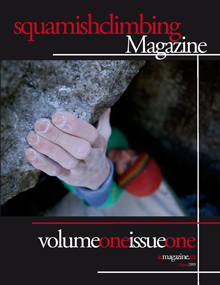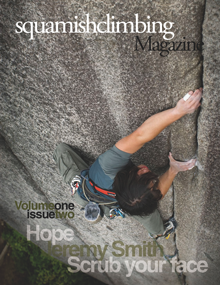Bonar McCallum started climbing in 1990. At the time, he was 24 years old, working and living in Langley, BC. A friend of his, Cliff Deyo, took him to the Smoke Bluffs in Squamish one day and instantly he was hooked. That winter, he participated in the great North American road trip, starting in Smith Rocks then down to Red Rocks, Yosemite, Bishop, and finally to Joshua Tree.
Flash forward 25 years and you still will find Bonar on the road. This year, Bonar and his wife, Lea Juszkiewicz, are starting in Rumney, NH and making their way down to the Red River Gorge. At the age of 49, Bonar sent his first 5.14’s last year, Bone Thief Extension (5.14a) and T-Rex (5.14a) and continued to put up hard routes in the Bow Valley. Not only that, he has been a strong force in the Alberta indoor climbing scene, coaching and mentoring a number of climbers during the competition season. With so many years of climbing under his belt, Bonar has a lot of wisdom to share, from his ideas about movement training to making sure you stretch, or perhaps more importantly, his ability to stay psyched for all these years.
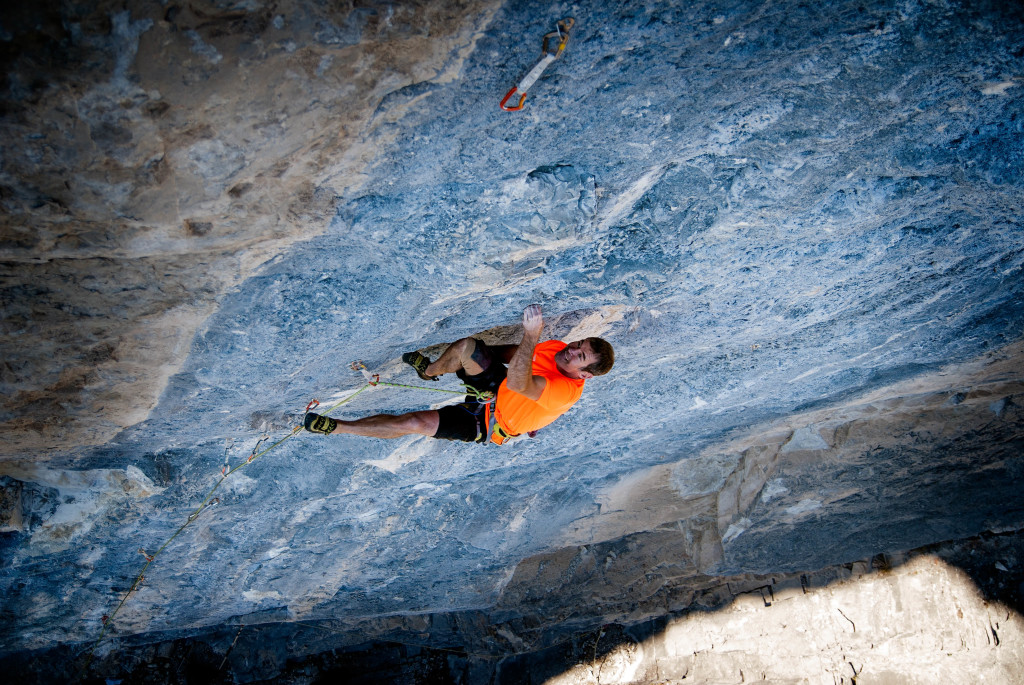
Bonar McCallum on Wedding Crashers (5.13a). Photo courtesy of Grzegorz Florek ©
Our interview with Bonar was completed during the week that he made the first ascent of Highway to the Danger Zone. Here is what he had to say.
Hi Bonar, thanks for taking the time to talk to us. Sounds like you had a great week to finish up your two projects! Can you tell us a bit about it?
Thanks Tim, it was a good week for me! I’m always happy to open new lines and I’m pleased with how these two turned out. I’m not sure made different this week, perhaps it was the weather! The previous week was terrible weather, it was unclimbable even for me, and maybe the forced down time gave me the rest I needed to send.
Let’s talk a little about the first project, Highway to the Danger Zone. How does it feel to finish up a big multi pitch project like this?
Well, in the real scope of things, it isn’t really all that big. It’s a sport route and only about 115 m long, there are a ton of other multi-pitch routes here that require a much higher level of commitment than this one. But as the difficulty was close to my top end, clipping the anchors on my send felt great. This line is one that I’ve looked at often while leaving the lookout, I think it is one of the most striking features on that side of the canyon. The whole process of finding the line, bolting it, discovering the sequences and finally red-pointing it was really rewarding.
On the day I redpointed it I really had to fight hard. My first attempt on the top pitch was close, but I had a foot slip at mid height just at the end of the second difficult section. I had to regroup and I wasn’t sure that I had it in me to get it done on the second attempt. So overcoming that doubt and getting it done made me very happy, and relieved!

Bonar on Sweet Thing (5.13b). Photo courtesy of Greg Tos©
What does it take to clean and prep a route like this?
Route development is one of those “type 2 fun” activities. There is a lot of work required. Scoping and envisioning a line is the start. Finding a line that grabs your imagination, looks clean enough to be good, and is something that you feel you can climb can be a challenge.
If you are going to work from the top down the next step is to find your way to the top of the wall with all your gear. Then you need to orient yourself to make sure you are starting at the right place. The top of a big cliff can be a sketchy place and it doesn’t always look the same from the top as from the ground. Finding an anchor point above the cliff to rap off (typically a tree) and hoping you are lowering to the place where you should be is an exciting process.
Once you’ve established that you are where you wanted to be, the real development work begins. Typically I work down on fixed lines. As I lower I’m discovering where the line goes, finding the clipping stances, placing bolts and cleaning off loose stuff. Usually the steeper line, the more strenuous it will be to bolt.
Safety is a big concern, both for yourself and others. Echo Canyon is a popular place so you want to make sure you don’t drop anything on anyone below. I did pull off a couple refrigerator sized blocks from this route so I had to make an effort to get out bolting on bad weather days when no one in their right mind was in the canyon.
The most time consuming and dirty part of the job is cleaning off ledges. They usually have accumulated lots of debris; dirt, rocks and pika droppings. It is important they are relatively clean because leaving stuff on them can be hazardous to your partner when climbing or rapping off them. The last process is cleaning off the fixed gear and then trying the climb. Hopefully the bolts are in the right spot and the route climbs relatively as you expected it to.
For this route, it took me approximately 8 full days of work to complete this process.
Any pitch really stick out as the best?
Absolutely the 3rd pitch is the best! I think it is one of the best pieces of climbing I’ve been on. The climbing is so varied, but at the same time sustained for a long way, and the position is great!

Bonar high up on a new project in Echo Canyon. Photo courtesy of Krissy Blakney ©
Any moment during the process that really sticks out for you?
I would say that being in a stance on the arete just after I completed the difficult climbing on my successful attempt. At that point the climbing above isn’t really hard but it is insecure. You blindly pull around a corner, your feet are on smears, and your hands are on side-pulls and pinches. The sun was in my eyes, and I remember being stuck there for a long time. I didn’t want to blow it and have to do the bottom hard part again. Any move I could see looked risky and I wanted it to feel perfect. I finally realized that I would have to just step out and do it. I needed to trust my ability and just climb even if it felt insecure.
Finding someone who is psyched to get out and climb something like this with you is also a big part of the experience. Kevin Wilson was a great partner, a very strong climber, and considerate enough to hold back until I got the FA. He was so close to red-pointing just after me, falling twice at the very end of the difficult climbing. I’m sure he will get the second ascent on his next day up there.
Okay! On to the second project. This one is called Micro-Minnie. Can you tell us a bit about this route?
Sure! It is a new line in the middle of the very popular Atlantis Wall, between Buffet Royale and Spicy Elephant. It was named after our road trip trailer. Also, I thought it would be kind of funny because the route is certainly not micro or minnie but some of the holds are!
The full line is around 45 meters long, with a mid anchor at around 35 meters. What I’ve completed so far is first section. I think it is 13c but it will need a couple other ascents to confirm the grade. I think the climbing is really great! In true Lookout style, there are multiple boulder problems with good rests between.
I’m working on the extension, which will most likely bump the grade up a couple letters on the full line. I had some breakthroughs last day on it, which I’m psyched about! I was thinking I might have to give it up to a stronger climber if I hadn’t figured out those sequences. Still I definitely need to put in some work on it but this will have to wait till next year as we will be away for most of the winter.
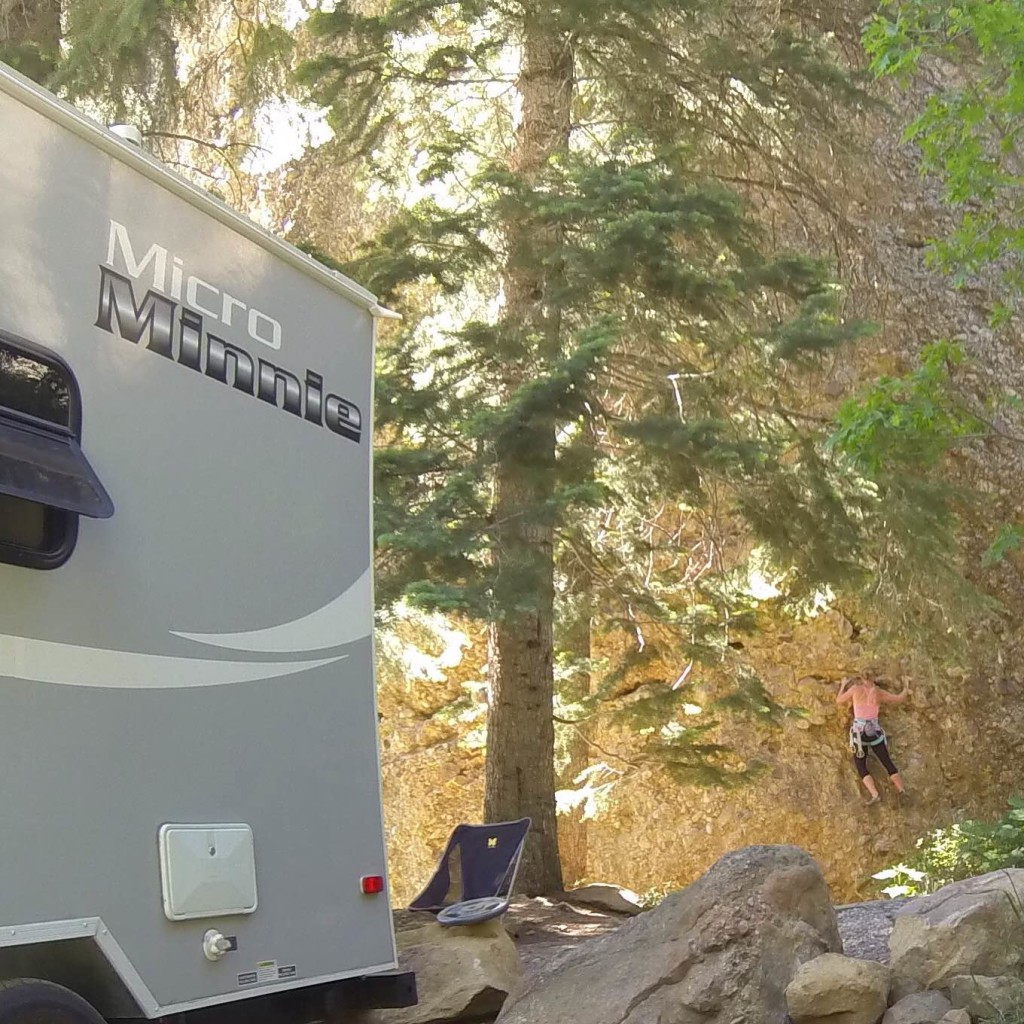
Name inspiration. Photo courtesy of Bonar McCallum ©
Seems like you love the hike to Echo!
It is kind of a love/hate relationship, but the views and the climbing definitely make it worth it!
Your progress over the years seems pretty steady. Is there anything you do to maintain progression in your climbing?
I really like training, and have been fortunate to be able to climb and train with a great community at the Calgary Climbing Centre. Having training partners like Josh Muller and Ben Blakney to really push me has made a huge difference. They are dedicated, strong, and constantly psyched.

Training with the Calgary crew. Photo courtesy of Bonar McCallum ©
Just like any specialty, climbing can take its toll on your body. In the past couple years I’ve focused a ton on how to stay healthy while climbing at a relatively high level. I signed up for personal strength training at Revolution Human Performance, Morgan Alexander really helped me in getting better mobility and overall functionality.
This past year I took a further step and signed up to be coached on-line by Ido Portal. He describes himself as a Mover. He has studied a huge range of disciplines in human movement from gymnastics, martial arts, yoga, parkour, dance, climbing, and much more. It seems his philosophy is to develop a practice that prepares your mind and body for virtually any physical pursuit. Rather than specializing in one specific discipline, he’s good at them all. He and his team have developed a method of training from their own practice and research. The program is intensive, I was told that it would involve 3-5 hours of training a day, at least 6 days per week. I dedicated all last winter to this, stepping away from climbing for around 8 months. I feel I came out the other end with a stronger, more balanced body, and I now have a much better idea of areas that I need to focus on for continued improvement.
I’m also fortunate to be married to a very talented physiotherapist Lea Juszkiewicz. Her company is called Peak Function, and she is (in my biased opinion) one of the leading experts in Canada when it comes to treating climbers. She’s definitely been a huge factor in keeping me healthy.

Bonar’s personal physiotherapist, Lea Juszkiewicz. Photo courtesy of Bonar McCallum ©
So you have been climbing for 25 years, you are 49 years old, How have you maintained your body throughout that time?
Well it has been hit and miss. I spend so many years just climbing, and I did pay for it. Pretty bad imbalances, and lack of mobility. It’s only been in the past few years that I’ve started to focus on real maintenance.
And did you ever go through a period of injuries where you had to change some of your practices like warming up cooling down etc?
Yes, I’ve injured both shoulders, one required surgery, had knee injuries, couple finger issues. When I look back at it I think many of these could have been avoided with a better overall program, but I just didn’t have the resources back then.. That being said, climbing is an intense activity, I think it is pretty hard to avoid all issues. My focus these days is to prep my body as well as possible to avoid injury, but also to be able to recover from injuries in an efficient way when they do happen.
My warm-up has changed drastically. I now go through a general joint mobility program daily, starting from my neck and working down through each joint until I reach my toes. Major mobility focuses for me are hips , thoracic spine, and shoulders. Progress is slow but it makes a huge difference.
I’ve also found that I need good support, especially when I’m training hard. I’ve used Physiotherapy, Osteopathy, Chiro, and massage with good results.
You have been involved in a lot of team and youth training in the Calgary area. What motivates you to be a part of the process with other climbers?
I love coaching, when you can make a difference in others it really is rewarding. On a personal note, I’ve found that because I really do want to help people improve, it forced me to learn. I had to become more educated in areas of training, coaching, prehab and rehab resources, competition strategy and the list goes on.
I feel Walson Tai, the owner of the Calgary Climbing Centre, gave me a great opportunity by trusting me with his adult team, and I feel I benefited greatly from being in this environment over the past few years.
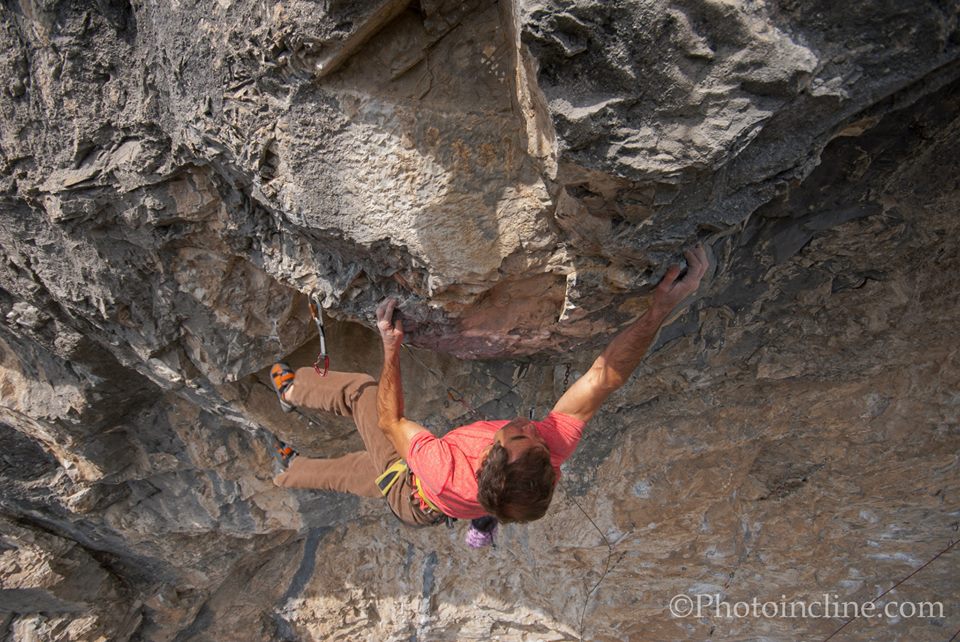
Bonar on Toxic Love (5.13d). Photo courtesy of Grzegorz Florek ©
Being a coach, what pieces of training do you put more emphasis on throughout the year?
This was a competitive bouldering team. We had a periodized approach to training that focused on different elements for each 4 to 6 week phase. The end goal was to get athletes to their peak performance for major competitions such as provincials and nationals. I would say that climbing movement was first and foremost, and every session included that. Other areas were strength, power and stamina.
Also, an important area where we dedicated a large amount of time was mobility and working on drills to keep the body in balance. This past year, athlete committed a full morning session plus at least 30 minutes in each training session to their rehab and prehab exercises.
This year you did a bit of travelling. How do you stay motivated on an extended roadtrip?
It isn’t hard for me to be motivated, as being able to spend time travelling and climbing is really a dream come true. It was important, however, to continue my movement training while on the road, and I did make an effort to do this. I feel it did make a difference.

All knee-padded up on the road. Photo courtesy of Bonar McCallum ©
You have been a big proponent of ‘Movement Training’. For those getting into movement training, where would you tell them to look?
The movement world is huge and diverse. I think climbers can benefit from exploring a wide range of practice outside their own discipline, including gymnastics, yoga, martial arts, dance, parkour, and much more. Exploring any of these will increase your overall movement knowledge.
By way of accessing movement experts out there, there is a ton of great free stuff on the web to get started. The list below is a good starting place, they have lots of free info, and most have a wealth of free youtupe content to get you started. I would recommend researching a number of options, you will find some will resonate and some will turn you off.
Here are a few people and websites I that I have used. I think they all have great stuff to offer:
Ido Portal
Kelly Starrett
Dr Andreo Spina
Gold Medal Bodies (GMB Fitness)
How well do you handle the rest days or the double rest days?
I wrote a training program so we would have a plan for our rest days. On the first day, I would do a strength session, either a bent arm or a straight arm workout. The second day I would do a Mobility and Equilibre workout. These kept me from getting bored and I believe they also kept me healthy.
Our sessions weren’t always perfect because we didn’t have access to training facilities. We made good use of city parks and playgrounds to facilitate our workouts. We always had interesting conversations with folks as they walked by us doing things like handstands against trees or hanging exercises from our rings suspended by branches.

Bonar sending Millennium (5.13d) in Maple Canyon. Photo courtesy of Bonar McCallum ©
Was it a big change to be on the road or did you adapt rather quickly?
Other than a traumatic squirrel incident (that’s another story!) I’d say we adapted pretty well.
Finally, I got to ask. What’s next?
For fall, Lea and I are travelling and climbing throughout North America. One of our primary goals is to do research for a new venture. There are a number of workshops that we will be participating in that will include climbing as well as human movement and training. First stop is Rumney NH!
Fantastic. Let us be the first to say have a great time on the road and can’t wait to hear from you again!
Bonar McCallum is currently sponsored by Flashed Climbing.

Bonar and Lea on their trip. Photo courtesy of Bonar McCallum ©











